Lessons in Working with Indigenous Forces
Ed Nash

Soldiers of the Kachin Independence Army drilling in Laiza, Northern Burma
Between June 2015 and August 2016, I fought as a volunteer with the Kurdish YPG against the Islamic State in Syria. That timespan saw the creation of what became the Syrian Democratic Forces (SDF), a disparate conglomeration of different groups of multiple ethnicities, that all had the common goal of destroying ISIS, a goal that has territorially been achieved but is in actuality far from complete.
In that time I had dealings with multiple former soldiers from a range of countries who were, like me, serving as volunteers, as well as the Special Forces of the United States, Britain, France and Belgium.
Though I have no military background, I came to Syria with extensive experience of both travelling abroad and with working with members of various Ethnic Armed Organisations (EAOs) in Burma, indigenous forces that have been fighting the government for decades.
As a result it might be of interest to those reading this to highlight some lessons that I learned that may be of use to personnel who find themselves supporting local forces in some function, even a non-military one. Many of these lessons will already be imparted to any professional soldier who finds themselves in this situation, but it may be instructive to read some of the observations I’ve made in real world application.
Importance of Understanding Local Customs and Languages
This would seem so obvious as to need no explanation, but in fact it can still lead to issues. An example is the conversation I had with a vexed USSF soldier who was ineffectually trying to control traffic at the ferry crossing his colleagues were running across the Euphrates river during the SDF’s assault on the town of Manbij in June 2016.
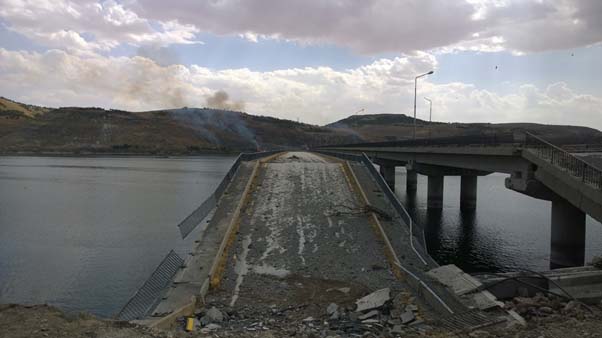
The destroyed bridge over the Euphrates. The SF-operated ferry is close to the far bank on the left.
The soldier in question had the impossible task of trying to stop every vehicle rushing forward and jamming the road whenever the small ferry pulled up to the bank. But what particularly peeved him was that the language course he had attended prior to his deployment seemed to have been in the wrong dialect.
As Kurdish has at least seven different versions, effectively completely different languages, this issue isn’t so surprising. But it did mean that SF troops were reliant on Kurdish translators or to requesting help from the foreign volunteers who had learned the language. It may seem obvious, but ensuring that you know the correct language is an easily overlooked factor. Many indigenous forces come from obscure ethnicities and often have diverse language groundings not well understood except by the most esoteric of scholars and it is easy for mistakes to occur during planning.
A potentially more dangerous factor is highlighted by the first time I met French special forces who were supporting the SDF. This occurred during the advance on Al Hawl in December 2015. The French made an effort to blend in, adopting SDF style uniforms and carrying Kalashnikovs. But to anyone with familiarity they stood out tremendously.
For starters, their equipment was just too good. The rifles were new and featured additions such as rails, scopes and lights, things pretty much unheard of in the SDF. Their uniforms, though the right camouflage, were also of excellent make, again something that was rare at that time.
The unit patches they wore also marked them out. All SDF wore shoulder patches of their host organisation. The French had also added patches, normally YPG flashes. But some had the distinctive green shield of the YPJ, the women’s counterpart to the YPG. This was not a done thing and marked the soldiers out as extremely peculiar. Imagine a man wearing a burkha!
But it was their facial hair that was of particular note. Kurds would sport moustaches and Arab SDF would have beards. But these would be kept short and clean; big beards were the affectation of ISIS and it was wise policy to not have facial hair like that of the enemy.
The French had great, bushy beards, essentially the style common in western special forces since the wars in Afghanistan and Iraq. These were something that I warned foreign volunteers against, as they could make you subject to friendly fire, a VERY common occurrence amongst indigenous forces anywhere. Should someone run across my scope with a heavy beard, I was highly likely to pull the trigger; combat moves too quickly to hesitate long on targets and so you really want to make sure you aren’t liable to be confused for the enemy. Adopt the look of your allies as much as possible.
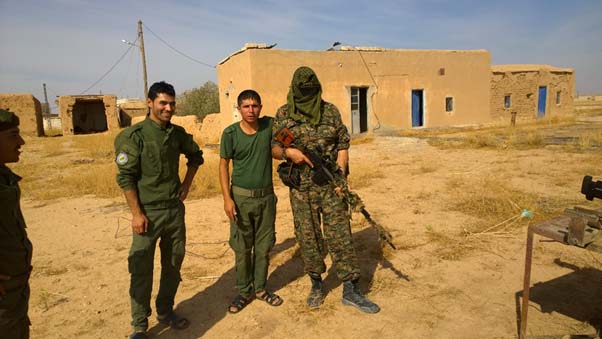
The author (far right) working with local SDF forces.
Expect Shifts in Political Dynamics
Local ethnic forces tend to have flexible loyalties as alliances shift and the situation in theatre changes. This can lead to literally friends becoming enemies and vice versa overnight. Amongst the EAO’s in Burma, it is extremely common for different groups to switch sides or fragment amongst themselves due to outside influence or due to personal dynamics in the leadership structures.
This tendency is a major reason for the Burmese Civil War running for so long and a similar situation existed among the Kurds in Iraq and Syria. In both areas most groups viewed the other regional actors as much as a threat to their own agendas as the external aggressors against them were.
A person working with ethnic forces should be aware that they may have to work at short notice with those who they were literally fighting the day before. I once had the experience of having a convoy of local Arab fighters who had switched sides that same day approach a Kurdish encampment in a bizarre “meet-and-greet” situation. Needless to say - as they were still dressed and equipped exactly like the ISIS fighters they had been up until hours before - you could cut the tension with a knife.
These shifting patterns need to be followed extremely closely as they are potentially disastrous for any mission goals you may have, plus a potential threat to your own well-being.
Value of Airpower (and in Countering It)
I’m sure it comes as no surprise to any reader that I consider the successful use of air power to be a force multiplier of immeasurable value in warfare. However I speak from the benefit of having worked with indigenous forces who benefited from copious quantities of air support, the SDF, as well as having worked with members of prodemocracy ethnic forces, principally the Kachin Independence Army (KIA) in Burma, who have been on the receiving end of strikes.
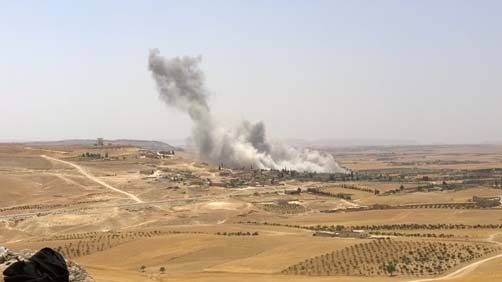
Tis far better to give than to receive! A coalition airstrike hit ISIS positions outside Manbij, Syria.
Precise air support was without doubt the most important element in the outside support received by the anti-ISIS forces and was the principle reason for the change of fortunes for the YPG in being able to switch from the defensive to the offensive during the Battle of Kobane of October 2014. Close air support was imperative to maintaining successful offensives and it was notable that when such assistance was reduced attacks tended to bog down rapidly in the face of increased resistance and casualties amongst assaulting troops.
However, while airpower is invaluable, do not make the mistake of thinking that you can take its use for granted. The Burma Army made this mistake in 2012 when they lost two Mi-35 gunships to heavy machine gun fire while fighting the Kachin. This was achieved by a single KIA machine gunner who observed that the gunships always attacked via the same approach and exit. He then climbed a nearby mountain with his gun, where he was able to shoot down both helicopters in rapid order by hitting them as they finished their attack runs.
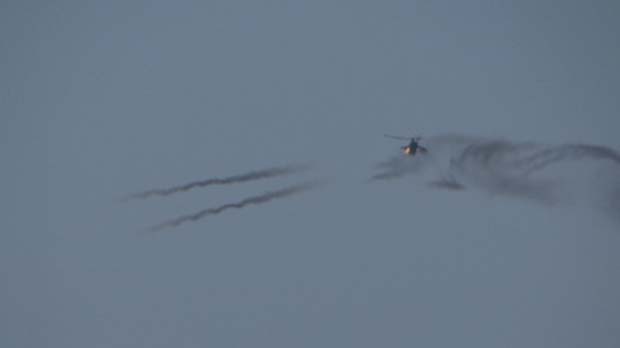
A Burma Army Mi-35 rockets Kachin positions, 2012. ©Free Burma Rangers
The loss of a fifth of their gunships led to the Burma Army becoming far more circumspect about using their helicopters and led to them taking far heavier losses amongst their infantry when they had to attack without such support.
Therefore, should you ever be on the receiving end, try to prioritise the neutralisation of enemy airpower. Success in this is hugely important in undermining enemy morale and lifting that of your own troops.
Switch Tactics
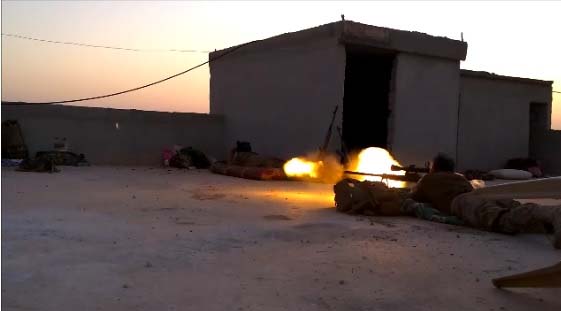
Foreign volunteers of the SDF engage ISIS with heavy sniper rifle. Manbij, 2016
The necessity to not be predictable highlighted in the previous section may seem, again, obvious but humans tend to fall into such patterns naturally. In a warzone, being predictable will get you killed.
Ethnic forces tend towards predictability just as larger national militaries do. They’re often limited by supply, geographic and political constraints, and this heavily influences the tactics they use. Smaller groups tend to have to rely on guerrilla or small unit skirmish tactics as their modus operandi, the book on which is well established. Equally well established is the book on how to counter them.
It can be difficult, even impossible, to alter an EAO’s operational pattern. They can be extremely conservative in their thinking. Additionally, as an outsider you may not actually fully comprehend the difficulties they face or the reasons for their actions.
That is not, however, a reason for you to act in the same way. Observe your hosts and their methods so as to understand them, but if it is obvious suicide don’t follow it. Again, it seems logical, but I have personally seen outsiders killed because they followed indigenous tactics on the grounds of “It’s what they do, so it must work”.
The rule with combat is always the same – don’t fight stupid.
Patience
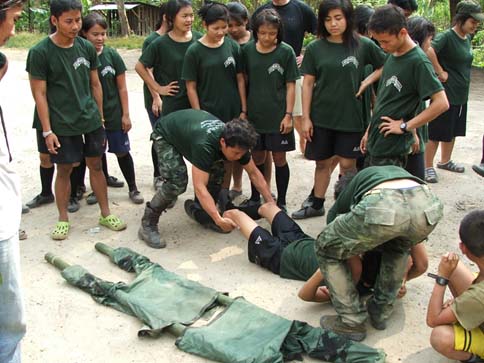
Members of the Free Burma Rangers and Karen National Liberation Army give a demonstration of how two bamboo poles and jackets can make an ersatz stretcher.
One universal theme I encountered, wherever I have worked and no matter the role, is that everything takes a long time. This is perhaps the most trying thing about working with different cultures, generally with scant available resources.
It is also the thing that drives foreigners, no matter their purpose, nuts.
You have a clear view of what the people you are there to assist need to do. It’s so obvious that you can’t believe they haven’t done it already! And yet your insistence that they follow a particular strategy/idea/objective are met with polite reassurances and ultimately nothing happens.
If you are involved in a warzone (and one assumes if you are reading this then that is the area of your interest) then remember this key fact – it’s their war. You’re not one of them. Unless you go full Colonel Kurtz, you never will be. You will, at some point, go home. They have to stay and deal with whatever the situation is. Their agendas likely have massive variances from your own, whatever that may be.
Again, seems obvious. But I’ve seen plenty of SF and former SF, people exquisitely trained for working with indigenous forces, raging and quitting in frustration because their expertise was being ignored, even when it was obviously sound.
Ultimately, they will do what they are going to do. All you can do is advise, they will take that advice as they see fit. Understand this and accommodate it.
Suffering for Previous Transgressions
If you find yourself working with ethnic groups, in any role, the possibility exists that they may have a cynical outlook on your nationality for real or perceived previous injustices; If you’re British, this is all but guaranteed.
The failure of previous administrations to fulfil prior promises can make any dealings with indigenous forces much more complicated. Ultimately, such actions are political in nature and therefore subject to political considerations. In Western cultures such factors are outside of the purview of even the most powerful military officers. However, the impact of broken promises is heart breaking to witness and leaves a bitterness that lasts for generations.
The best examples of these I have witnessed amongst ethnic minorities in Burma, principally the Kachin and the Karen. Both fought steadfastly alongside Allied forces as guerrillas during the Second World War against the Japanese and received promises of support in the post-war world which were subsequently forgotten once they were no longer needed.[i]
On one occasion I was working with a Kachin NGO and teaching English at a school. There I was frequently asked why the Americans had forgotten the Kachin. To provide some background, American missionaries have been the most important influence on developing Kachin culture, providing a written language and pushing the Kachin from a diverse group of perpetually warring hill tribes into a more cogent group identity. It is because of this that the Kachin are almost entirely Christian and use the Latin alphabet, a somewhat rare situation in Asia.
Because of this huge influence the Kachin consider the Americans as a sort of big brother. For this reason the Kachin flocked to fight alongside OSS teams as guerrillas against the Japanese after their invasion of Burma and, as tough mountain and jungle fighters, proved exceptionally loyal, capable and formidable fighters.
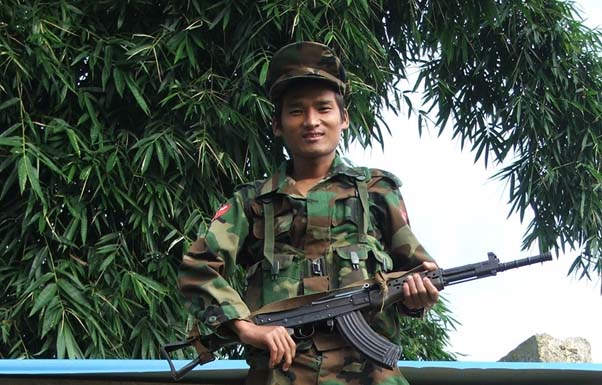
A soldier of the Kachin Independence Army strikes a pose.
As a result the subsequent withdrawal of American support, followed by the complete forgetting of the Kachin by their “big brothers”, is both a source of confusion and pain to the Kachin. Attempts to explain it away in the light of political realities and how spheres of influence evolve quite frankly ring hollow even in the explainer’s ears. To people that tend to rely on the value of the personal word such concepts are of limited value in the face of broken promises.
In terms of how such actions can impact over the future, my personal experience with the Karen of eastern Burma resounds, and bears warning to how future efforts may be made problematic by old betrayals that are no longer remembered by the perpetrators but are certainly remembered by those who have had to endure the consequences. Such old wounds do linger and can impede your ability to form necessary relations with ethnic peoples through no fault of your own.
On several occasions Karen, on learning that I was British, have become if not outright hostile towards me then certainly less welcoming. As one old fighter put it: “You said you’d help us. Then you left.”
Note the direct association between myself and a British government that made a decision before my father was born. People have long memories, especially when they’ve have been fighting wars for generations based on those decisions.
Therefore any person intending to work with indigenous forces, regardless of their reasons or role, should learn as much about that particular group and ethnicity’s history especially in terms of their prior relations with your own country. You might find that some ancient slight, long forgotten in your own history books, is very much remembered by those you would hope to help.
Knowing of such issues beforehand makes it easier to prepare for any such ill feeling and how to diffuse it. The most effective way to do that is to deliver on your own guarantees and also not to get carried away and start making promises that you cannot keep – an all too easy when you see how desperate the straits of some people are from war.
End Note
[i] Though not by those they served alongside. Anyone interested in former SOE agents going rogue and trying to help their wartime friends should read Richard J. Aldrich (1999): Legacies of Secret Service: Renegade SOE and the Karen Struggle in Burma, 1948–50, Intelligence and National Security, 14:4, 130-148
